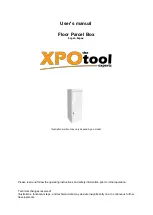
Using the Graphic User Interface (GUI)
This section provides an introduction to the GUI.
Understanding the GUI
The GUI is consisted of the following components,
1.
Configuration categories: Located on the left side of each page. Lists the
configuration categories on this device. To get access to each category, click on
the button that you are going to configure.
2.
Configuration items: Located on the right side of each page. Shows the items
that can be configured. You can click on the tabs that listed above to access to
each sub-categories.
Note: For detail information about configuring each item, please refer to the
management instruction for each configuration category.
Management items list
The following table lists the information and items that you can configure with the
GUI. For detail instruction, please refer to the following chapter.
Category Sub-category
Information
Status
Status Shows
the
status information of this device
including Host name, IP address, HD used
percentage, system up-time, firmware version,
current Samba users and FTP users, firmware
extension loaded and eSATA connecting status.
Disk
Folder
To add a new folder, delete a folder, change
folder-access authentication and set up folder
properties.
Disk
To format the connected SATA interface hard disk
in EXT3 Format..
Network
Host
To change the device’s host name, Work group
name and description.
IP address
To configure the network settings for the device
including IP address, Subnet Mask, Gateway,
DNS server, DHCP enable/ disable and Jumbo
mode selecting.
System
Administrator To change the administrator name and
password.
Time
To set up the system time zone, synchronize time
and assign a timeserver for the device.
User
To add a new user, delete a user, setup user
authorities and change user properties.
Group
To make users in groups. Add users to groups or
delete users from groups.
Option
FTP
Change FTP properties including Maximum unit
number, Port number, Timeout setting and
24
















































